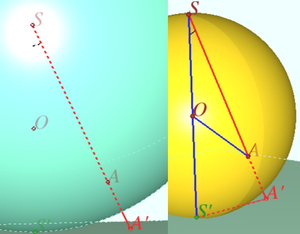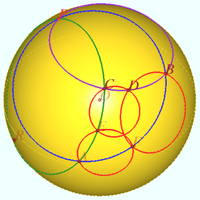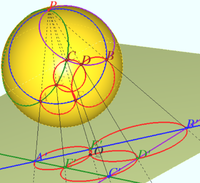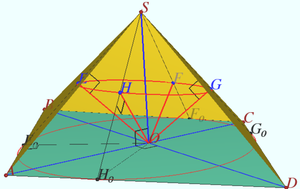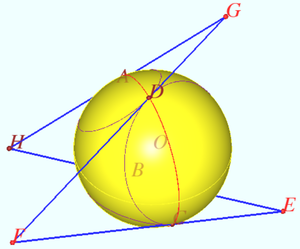Stereographic projection
A stereographic projection is a projection from a sphere to a tangent plane. Stereographic projections preserve angles.
To stereographically project a point on a sphere to a plane tangent to its south pole, draw the line from the north pole of the sphere to the point in question. The stereographic projection of this point is then the intersection of this line with the plane. As such, the stereographic projection of the north pole will be undefined.If we completing the plane by adding a point at infinity the north pole maps to this point.
The stereographic projection of a sphere centered at ![]() with radius
with radius ![]() from its point
from its point ![]() on the set of points of this sphere coincides with the inversion of space relative to the sphere centered at
on the set of points of this sphere coincides with the inversion of space relative to the sphere centered at ![]() with radius
with radius ![]()
Stereographic projection is a special case of inversion, so:
- a circle on a sphere passing through point ![]() maps into a line in the projection plane;
maps into a line in the projection plane;
- a circle on a sphere not passing through point ![]() maps into a circle in the projection plane;
maps into a circle in the projection plane;
- angles between curves are preserved;
- tangent curves are maps into tangent ones;
- lines and circles of a plane are projected onto a sphere into circles, respectively passing and not passing through point ![]()
Three circles on the sphere
Three circles ![]() and
and ![]() are given on a sphere. Points
are given on a sphere. Points ![]() different from points
different from points ![]() and
and ![]() are chosen on these circles.
are chosen on these circles.
Prove that circles ![]() and
and ![]() intersect at one point.
intersect at one point.
Proof
Let us consider a stereographic projection from point ![]()
With this transformation, circles ![]() and
and ![]() will be transformed into lines
will be transformed into lines ![]() and
and ![]() Circles
Circles ![]() and
and ![]() will be transformed into circles
will be transformed into circles ![]() and
and ![]()
It is known that such circles intersect at one point ![]()
Thus, the desired intersection point is the preimage ![]() of point
of point ![]()
Pyramid
Let a pyramid ![]() be given. Its base is a quadrilateral
be given. Its base is a quadrilateral ![]() The altitude of a pyramid is
The altitude of a pyramid is ![]() where
where ![]() is the intersection point of the lines
is the intersection point of the lines ![]() and
and ![]()
Prove that the bases of the perpendiculars dropped from the point ![]() to the lateral faces of the pyramid lie on one circle.
to the lateral faces of the pyramid lie on one circle.
Proof
Let ![]() be the foot from
be the foot from ![]() to plane
to plane ![]() .
.
Let ![]() be the foot from
be the foot from ![]() to
to ![]() .
.
Denote ![]() similarly.
similarly.
![]() is cyclic.
is cyclic.
![]() is cyclic.
is cyclic.
![]() lies on the sphere with diameter
lies on the sphere with diameter ![]() so
point
so
point ![]() is a stereographic projection of point
is a stereographic projection of point ![]() from point
from point ![]()
Therefore ![]() and
and ![]() are cyclic simultaneously.
are cyclic simultaneously.
Moscow Math Olympiad, 1950
A spatial quadrilateral is circumscribed about the sphere.
Prove that the four points of contact lie in one plane.
Proof
Let given quadrilateral be ![]() the points of contact be
the points of contact be ![]() the north pole of the sphere be point
the north pole of the sphere be point ![]() Denote sphere as
Denote sphere as ![]()
Let plane ![]() cross sphere at circle
cross sphere at circle ![]() Points
Points ![]() and
and ![]() lies on
lies on ![]() Similarly define circles
Similarly define circles ![]() with points
with points ![]() and
and ![]() with points
with points ![]() and
and ![]() with points
with points ![]() and
and ![]()
This circles lies in different planes and have the common points, so they are tangent in pares.
The stereographic projection from point ![]() is shown on diagram. Points
is shown on diagram. Points ![]() maps into points
maps into points ![]() tangent circles
tangent circles ![]() and
and ![]() maps into tangent circles
maps into tangent circles ![]() and
and ![]() circles
circles ![]() and
and ![]() maps into parallel lines
maps into parallel lines ![]() and
and ![]() tangent to circles
tangent to circles ![]() and
and ![]() respectively.
respectively.
Condition that points ![]() lie in one plane transforms into condition that points
lie in one plane transforms into condition that points ![]() are collinear which is trivial.
are collinear which is trivial.
This article is a stub. Help us out by expanding it.





